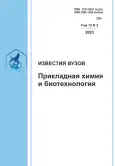Developing approaches for search and analysis of CRISPR-Cas systems on the example of Klebsiella pneumoniae strains as a basis for creating personalized bacteriophage therapy
- Authors: Stepanenko L.A.1, Sukhov B.G.2, Bedinskaya V.V.1, Borisenko A.Y.1, Kon’kova T.V.2
-
Affiliations:
- Irkutsk State Medical University
- Voevodsky Institute of Chemical Kinetics and Combustion
- Issue: Vol 13, No 2 (2023)
- Pages: 197-205
- Section: Physico-chemical biology
- URL: https://ogarev-online.ru/2227-2925/article/view/301293
- DOI: https://doi.org/10.21285/2227-2925-2023-13-2-197-205
- EDN: https://elibrary.ru/OCOJTN
- ID: 301293
Cite item
Full Text
Abstract
About the authors
L. A. Stepanenko
Irkutsk State Medical University
Email: steplia@mail.ru
B. G. Sukhov
Voevodsky Institute of Chemical Kinetics and Combustion
Email: boris_sukhov@mail.ru
V. V. Bedinskaya
Irkutsk State Medical University
Email: vika-2801@mail.ru
A. Yu. Borisenko
Irkutsk State Medical University
Email: 89500720225@mail.ru
T. V. Kon’kova
Voevodsky Institute of Chemical Kinetics and Combustion
Email: konbuivol_2@yahoo.com
References
- Gasiunas G., Barrangou R., Horvath P., Siksnys V. Cas9-crRNA ribonucleoprotein complex mediates specific DNA cleavage for adaptive immunity in bacteria // Proceedings of the National Academy of Sciences. 2012. Vol. 109, no. 39. P. E2579–E2586. https://doi.org/10.1073/pnas.1208507109.
- Mojica F.J.M., Díez-Villaseñor C., Soria E., Juez G. Biological significance of a family of regularly spaced repeats in the genomes of Archaea, Bacteria and mitochondria // Molecular Microbiology. 2000. Vol. 36, no. 1. P. 244–246. https://doi.org/10.1046/j.13652958.2000.01838.x.
- Bolotin A., Quinquis B., Sorokin A., Ehrlich S.D. Clustered regularly interspaced short palindrome repeats (CRISPRs) have spacers of extrachromosomal origin // Microbiology (Reading). 2005. Vol. 151, no. 8. P. 2551–2561. https://doi.org/10.1099/mic.0.28048-0.
- Mojica F.J.M., Díez-Villaseñor C., García-Martínez J., Soria E. Intervening sequences of regularly spaced prokaryotic repeats derive from foreign genetic elements // Journal of Molecular Evolution. 2005. Vol. 60, no. 2. P. 174–182. https://doi.org/10.1007/s00239004-0046-3.
- Shmakov S.A., Makarova K.S., Wolf Y.I., Severinov K.V., Koonin E.V. Systematic prediction of genes functionally linked to CRISPR-Cas systems by gene neighborhood analysis // Proceedings of the National Academy of Sciences. 2018. Vol. 115, no. 23. Р. 5307– 5316. https://doi.org/10.1073/pnas.1803440115.
- Pourcel C., Salvignol G., Vergnaud G. CRISPR elements in Yersinia pestis acquire new repeats by preferential uptake of bacteriophage DNA, and provide additional tools for evolutionary studies // Microbiology. 2005. N 151. Р. 653–663. https://doi.org/10.1099/mic.0.27437-0.
- Makarova K.S., Wolf Y.I., Alkhnbashi O.S., Costa F., Shah S.A., Saunders S.J., et al. An updated evolutionary classification of CRISPR-Cas systems // Nature Reviews Microbiology. 2015. Vol. 13, no. 11. P. 722–736. https://doi.org/10.1038/nrmicro3569.
- Shmakov S., Smargon A., Scott D., Cox D., Pyzocha N., Yan W., et al. Diversity and evolution of class 2 CRISPR-Cas systems // Nature Reviews Microbiology. 2017. Vol. 15, no. 3. P. 169–182. https://doi.org/10.1038/nrmicro.2016.184.
- Koonin E.V. CRISPR: a new principle of genome engineering linked to conceptual shifts in evolutionary biology // Biology & Philosophy. 2019. Vol. 34, no. 9. https://doi.org/10.1007/s10539-018-9658-7.
- Barrangou R., Flemaux C., Deveau H., Richards M., Boyaval P., Moineau S., et al. CRISPR provides acquired resistance against viruses in prokaryotes // Science. 2007. Vol. 315. P. 1709–1712. https://doi.org/10.1126/science.1138140.
- Gasiunas G., Sinkunas T., Siksnys V. Molecular mechanisms of CRISPR-mediated microbial immunity // Cellular and Molecular Life Sciences. 2014. Vol. 71. P. 449–465. https://doi.org/10.1007/s00018-0131438-6.
- Hille F., Charpentier E. CRISPR-Cas: biology, mechanisms and relevance // Philosophical Transactions of the Royal Society B: Biological Sciences. 2016. Vol. 371, no. 1707. P. 20150496. https://doi.org/10.1098/rstb.2015.0496.
- Косенчук В.В., Рыбалкина Т.Н., Бошьян Р.Е., Каражас Н.В., Корниенко М.Н., Веселовский П.А.. Роль возбудителей оппортунистических инфекций как этиологических агентов внутриутробных инфекций // Детские инфекции. 2019. Т. 18. N 3. C. 17–24. https://doi.org/10.22627/2072-8107-2019-18-3-17-24.
- Brauberg C.A., Palacios M., Miller V.L. Klebsiella: a long way to go towards understanding this enigmatic jetsetter // F1000Prime Reports. 2014. Vol. 6, no. 64. https://doi.org/10.12703/P6-64.
- Хаертынов Х.С., Анохин В.А., Николаева И.В., Семенова Д.Р., Любин С.А., Агапова И.В.. Клебсиеллезный неонатальный сепсис // Медицинский вестник Северного Кавказа. 2016. Т. 11. N 1. С. 82–86. https://doi.org/10.14300/mnnc.2016.11004.
- Moore R., O’Shea D., Geoghegan T., Mallon P.W.G., Sheehan G. Community-acquired Klebsiella pneumoniae liver abscess: an emerging infection in Ireland and Europe // Infection. 2013. Vol. 41, no. 3. Р. 681–686. https://doi.org/10.1007/s15010013-0408-0.
- Агеевец В.A., Агеевец И.В., Сидоренко С.В. Конвергенция множественной резистентности и гипервирулентности у Klebsiella pneumoniae // Инфекция и иммунитет. 2022. Т. 12. N 3. C. 450–460. https://doi.org/10.15789/2220-7619-COM-1825.
- Gu D., Dong N., Zheng Z., Lin D., Huang M., Wang L., et al. Afataloutbreakof ST11 carbapenem-resistant hypervirulent Klebsiella pneumoniae in a Chinese hospital: a molecular epidemiological study // The Lancet Infectious Diseases. 2018. Vol. 18, no. 1. P. 37–46. https://doi.org/10.1016/S1473-3099(17)30489-9.
- Lam M.M.C., Wyres K.L., Duchene S., Wick R.R., Judd L.M., Gan Y.H., et al. Population genomics of hypervirulent Klebsiella pneumoniae clonal-group 23 reveals early emergence and rapid global dissemination // Nature Communications. 2018. Vol. 9, no. 1. P. 2703. https://doi.org/10.1038/s41467018-05114-7.
- Liu Y., Long D., Xiang T.X., Du F.L., Wei D.D., Wan L.G., et al. Whole genome assembly and functional portrait of hypervirulent extensively drug-resistant NDM-1 and KPC-2 co-producing Klebsiella pneumoniae of capsular serotype K2 and ST86 // Journal of Antimicrobial Chemotherapy. 2019. Vol. 74, no. 5. P. 1233–1240. https://doi.org/10.1093/jac/dkz023.
- Murray C.J.L., Ikuta K.Sh., Sharara F., Swetschinski L., Aguilar G.R., Gray A., et al. Global burden of bacterial antimicrobial resistance in 2019: a systematic analysis // Lancet. 2022. Vol. 399, no. 10325. Р. 629–655. https://doi.org/10.1016/S0140-6736(21)02724-0.
- Степаненко Л.А., Джиоев Ю.П., Злобин В.И., Борисенко А.Ю., Саловарова В.П., Арефьева Н.А.. Разработка подходов скрининга высокоспецифичных бактериофагов на основе биоинформационного анализа структур CRISPR-Cas систем Corynebacterium diphtheria // Известия вузов. Прикладная химия и биотехнология. 2021. Т. 11. N 2. С. 216–227. https://doi.org/10.21285/2227-29252021-11-2-216-227.
Supplementary files










